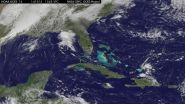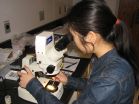Uncontrolled hypertension highest among patients with moderate-to-severe psoriasis
2014-10-15
(Press-News.org) Bottom Line: Patients with moderate and severe psoriasis have the greatest likelihood of uncontrolled hypertension compared to patients without psoriasis.
Author: Junko Takeshita, M.D., Ph.D., of the University of Pennsylvania Perelman School of Medicine, Philadelphia, and colleagues.
Background: Psoriasis is a chronic inflammatory disease of the skin and cardiovascular risk factors, including hypertension, are more prevalent among patients with psoriasis compared to those patients without. Previous studies suggest that psoriasis, especially when it is more severe, is associated with an increased risk of cardiovascular events such as heart attack, stroke and death.
How the Study Was Conducted: The authors examined the effect of psoriasis and its severity (which was measured by affected body surface area) on blood pressure control among patients with hypertension. The study included 1,322 patients with psoriasis and hypertension and 11,977 controls with hypertension but without psoriasis.
Results: The authors discovered a "dose-response relationship" between uncontrolled hypertension and psoriasis severity, which means the likelihood of uncontrolled hypertension increased with severity of the skin condition. Hence, the likelihood of uncontrolled hypertension was greatest among patients with moderate and severe psoriasis. Patients with psoriasis were equally as likely to be receiving antihypertensive treatment as were patients without psoriasis. The likelihood of treatment did not differ by the severity of the psoriasis.
Discussion: "Adding to the currently limited understanding of the effects of comorbid disease on hypertension, our findings have important clinical implications, suggesting a need for more effective management of blood pressure in patients with psoriasis, especially those with more extensive skin involvement [greater than or equal to 3 percent of body surface area affected]."
INFORMATION:
JAMA Dermatology. Published online October 15, 2014. doi:10.1001/jamadermatol.2014.2094.
Authors made conflict of interest disclosures. The study was supported by grants from the National Heart, Lung and Blood Institute, the National Institute of Arthritis and Musculoskeletal and Skin Diseases and other sources. Please see the article for additional information, including other authors, author contributions and affiliations, financial disclosures, funding and support, etc.
To contact author Junko Takeshita, M.D., Ph.D., call or email Katie Delach.
ELSE PRESS RELEASES FROM THIS DATE:
2014-10-15
Removal of the entire lobe of lung may offer patients with early-stage lung cancer better overall survival when compared with a partial resection, and stereotactic ablative radiotherapy (SABR) may offer the same survival benefit as a lobectomy for some patients, according to a study from The University of Texas MD Anderson Cancer Center.
The research is the largest population-based study to review modern treatment modalities for early-stage lung cancer and is published in JAMA Surgery.
According to the American Cancer Society, in 2014, 224,210 people in the U.S. are ...
2014-10-15
TORONTO, Oct 15, 2014 – Few topics can prove more divisive than religion, with some insisting it promotes compassion, selflessness and generosity, and others arguing that it leads to intolerance, isolation and even violence.
New research conducted at York University, published in the Journal of Personality and Social Psychology, may shed some light on religion's actual influence on believers – and the news is positive.
"Based on our premise that most people's religious beliefs are non-hostile and magnanimous, we hypothesized that being reminded of religious ...
2014-10-15
New York, NY, October 16, 2014 – Evidence-based guidelines play an increasing role in setting standards for medical practice and quality but are seldom systematically evaluated in the practice setting. Investigators evaluated the rate of physician adherence to the American Urological Association's (AUA) guidelines on the management of benign prostatic hyperplasia/lower urinary tract symptoms (BPH/LUTS) to establish a benchmark for future research. Their findings are published in The Journal of Urology®.
Medical certification bodies, for example, the American ...
2014-10-15
NASA's Aqua satellite passed over intensifying Tropical Storm Ana as it was moving through the Central Pacific Ocean and toward the Hawaiian Islands.
On Oct. 14 at 22:50 UTC (6:50 p.m. EDT) the MODIS instrument aboard NASA's Aqua satellite captured a visible image of Tropical Storm Ana in the Central Pacific Ocean. The MODIS image showed a tight concentration of thunderstorms surrounding the center of Ana's circulation.
At 1500 UTC (11 a.m. EDT/5 a.m. HST) on Wed. Oct. 15, Tropical Storm Ana's maximum sustained winds were near 70 mph (110 kph). Ana is forecast to gradually ...
2014-10-15
VIDEO:
This animation of visible and infrared images from NOAA's GOES-East satellite shows the movement and strengthening of Gonzalo from a tropical storm on Oct. 13 to a hurricane on Oct....
Click here for more information.
Hurricane Gonzalo has made the jump to major hurricane status and on Oct. 15 was a Category 4 storm on the Saffir-Simpson Hurricane Scale. NOAA's GOES-East satellite provided imagery of the storm. According to the National Hurricane Center, Gonzalo is the ...
2014-10-15
Nanomedicines consisting of nanoparticles for targeted drug delivery to specific tissues and cells offer new solutions for cancer diagnosis and therapy. Understanding the interdependency of physiochemical properties of nanomedicines, in correlation to their biological responses and functions, is crucial for their further development of as cancer-fighters.
"To develop next generation nanomedicines with superior anti-cancer attributes, we must understand the correlation between their physicochemical properties—specifically, particle size—and their interactions ...
2014-10-15
Researchers in Syracuse University's College of Arts and Sciences are pairing chemical analyses with micropaleontology—the study of tiny fossilized organisms—to better understand how global marine life was affected by a rapid warming event more than 55 million years ago.
Their findings are the subject of an article in the journal Paleoceanography (John Wiley & Sons, 2014).
"Global warming impacts marine life in complex ways, of which the loss of dissolved oxygen [a condition known as hypoxia] is a growing concern" says Zunli Lu, assistant professor of ...
2014-10-15
A new study using a reconstruction of North American drought history over the last 1,000 years found that the drought of 1934 was the driest and most widespread of the last millennium.
Using a tree-ring-based drought record from the years 1000 to 2005 and modern records, scientists from NASA and Lamont-Doherty Earth Observatory found the 1934 drought was 30 percent more severe than the runner-up drought (in 1580) and extended across 71.6 percent of western North America. For comparison, the average extent of the 2012 drought was 59.7 percent.
"It was the worst by a ...
2014-10-15
This week, researchers from University of Hawai'i, Norway, and the UK have shown with innovative experiments that a rise in jellyfish blooms near the ocean's surface may lead to jellyfish falls that are rapidly consumed by voracious deep-sea scavengers. Previous anecdotal studies suggested that deep-sea animals might avoid dead jellyfish, causing dead jellyfish from blooms to accumulate and undergo slow degradation by microbes, depleting oxygen at the seafloor and depriving fish and invertebrate scavengers, including commercially exploited species, of food.
Globally ...
2014-10-15
PROVIDENCE, R.I. [Brown University] — Imagine that a time machine has transported you to the Australian outback 100,000 years ago. As you emerge, you see a huge kangaroo with a round rabbit-like face foraging in a tall bush nearby. The animal's surprising size makes you gasp aloud but when it hears you, becoming equally unnerved, it doesn't hop or lumber away on all fours and tail like every kangaroo you've seen in the present. It walks on its feet. One at a time. Like you.
In a new paper in the journal PLoS ONE, a team of researchers led by Christine Janis, professor ...
LAST 30 PRESS RELEASES:
[Press-News.org] Uncontrolled hypertension highest among patients with moderate-to-severe psoriasis





